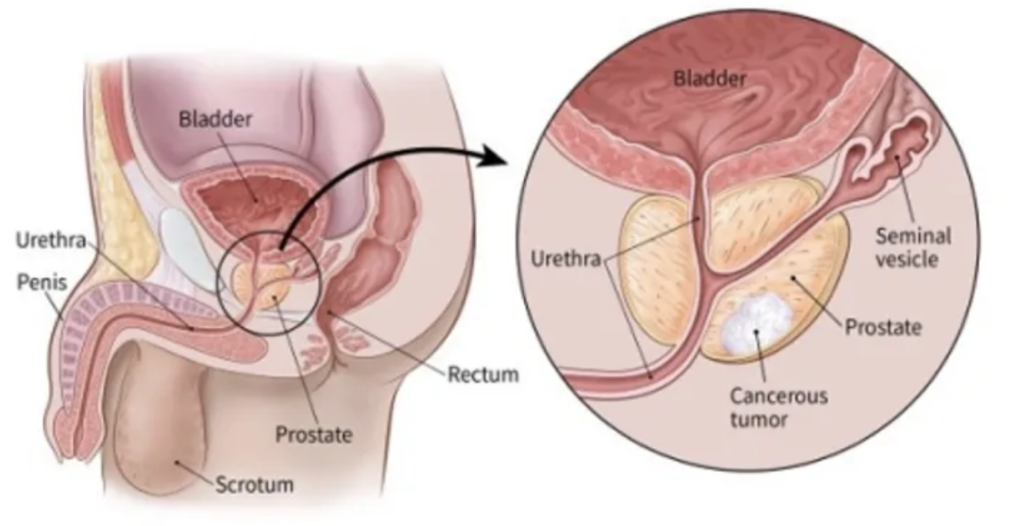ARE YOU AT RISK OF THE MOST COMMON CANCER IN MEN?
Every year, 1.3 million men worldwide are diagnosed with prostate cancer. In Australia and in the United States, prostate cancer is the most common cancer affecting men (with the exception of non-melanoma skin cancer). Prostate cancer is also the second leading cause of cancer death among men.
SO WHAT IS THE PROSTATE AND WHAT IS PROSTATE CANCER?
The prostate is a small gland that sits just below the bladder and surrounds the urethra – the passage through which urine and semen pass into and through the penis. It is about the size of a golf ball. The prostate is part of the male reproductive system. It produces most of the fluid that makes up semen and provides nutrition for sperm.
Prostate cancer occurs when abnormal cells develop and grow in the prostate. There are different types of prostate cancer. Prostate cancer has the potential to grow and spread quickly to other parts of the body. This type of high grade prostate cancer can cause serious harm and become life threatening. Most of the time, however, prostate cancer cells grow very slowly. The majority of men with low grade prostate cancer live for many years without it causing any symptoms and without it spreading or becoming serious.

HERE ARE 10 IMPORTANT FACTS TO KNOW
ABOUT PROSTATE CANCER
1. IN AUSTRALIA, 1 IN EVERY 7 MEN ARE LIKELY TO BE DIAGNOSED WITH PROSTATE CANCER DURING THEIR LIFETIME
There are over 200,000 Australian men currently living with prostate cancer and this year 20,000 more Australian men will be diagnosed and 3,500 will die of prostate cancer. In the United States, this year, an estimated 191,930 men will be diagnosed with prostate cancer.

2. SURVIVAL RATES FOR PROSTATE CANCER ARE HIGH
A man’s individual survival from prostate cancer depends on the type of prostate cancer and the stage of the disease. Prostate cancer is generally a slow-growing cancer. In Australia, the 5-year survival rate of prostate cancer that is localised to the prostate is over 95%, which means that men with localised prostate cancer have a high chance of survival.
For men diagnosed with prostate cancer that has spread to other parts of the body, either because the cancer was diagnosed late or because the prostate cancer was the more aggressive type, the 5-year survival rate is about 30%.
3. THE RISK OF DEVELOPING PROSTATE CANCER INCREASES RAPIDLY FROM AGE 50
Prostate cancer is more common in older men over the age of 50. In Australia, 63% of cases are diagnosed in men over 65 years of age.
Although prostate cancer is uncommon in men younger than 50, it is still possible. If you have any symptoms discussed in this article please see your doctor for further assessment.
4. HAVING A FATHER OR BROTHER WITH PROSTATE CANCER MORE THAN DOUBLES YOUR RISK OF HAVING PROSTATE CANCER
If you have a first degree relative (father or brother) who was diagnosed with prostate cancer before the age of 65, your risk of developing prostate cancer is 2-3 times higher than the average risk. This risk increases even further with the number of relatives diagnosed with prostate cancer.

5. A FAMILY HISTORY OF BREAST, OVARIAN OR COLON CANCER MAY INCREASE YOUR RISK OF DEVELOPING PROSTATE CANCER
Mutations in the BRCA1 or BRCA2 genes associated with breast and ovarian cancer or having a genetic condition called Lynch syndrome may increase your risk of developing prostate cancer.

6. AFRICAN AMERICAN MEN ARE MORE LIKELY TO DEVELOP PROSTATE CANCER
African American men are more likely to develop prostate cancer, are more likely to have advanced cancer at the time of diagnosis and are more than twice as likely to die from prostate cancer than Caucasian men.
This may be due to a combination of factors, including inherited genetic mutations and environmental factors such as dietary differences, access to medical care and delayed diagnosis.
7. SYMPTOMS OF PROSTATE CANCER RELATE TO PROBLEMS WITH URINATION
Due to the location of where the prostate sits relative to the urethra (the urinating tube), an enlarged prostate will result in symptoms related to the flow of urine.
These symptoms include:
- difficulty starting to pass urine (hesitancy)
- a weaker stream of urine or starting and stopping during urination (reduced stream)
- dribbling of urine at the end of urination (terminal dribbling)
- getting up to pass urine more than 2 times through the night (nocturia)
- blood in the urine or semen
- pain in the back or lower abdomen
It is important to note that these symptoms may also be related to prostate enlargement that may not be caused by prostate cancer.
Some people with prostate cancer may also present with symptoms affecting the rest of the body, such as:
- tiredness
- lack of appetite
- unexplained weight loss
- bone pain
- change in bowel habits

8. THERE ARE 3 MAIN TESTS FOR PROSTATE CANCER
The following are the current tests for prostate cancer:
- Prostate Specific Antigen (PSA) test – a blood test, which detects levels of a protein released by prostate tissue. An elevated PSA can indicate prostate cancer, however it can also be due to conditions other than cancer – eg.inflammation or infection of the prostate (prostatitis) or Benign Prostatic Hypertrophy (BPH) (benign enlargement of the prostate).
- Digital Rectal Examination (DRE) – DRE is a clinical examination whereby a doctor inserts a gloved finger into the anus to palpate the prostate against the wall of the bowel to detect any irregularities in the size, shape and consistency of the prostate. DRE is no longer recommended as a routine screening test. Ifyou do not have any symptoms, a DRE does not adequately detect prostate cancers early enough. If you have symptoms, however, your doctor may perform a DRE to assess your prostate for abnormalities.
- Prostate Biopsy – A biopsy may be recommended if there is an elevated PSA or a rapid rise in PSA. A biopsy is a procedure performed under anaesthetic. Samples of prostate tissue are removed and analysed to confirm whether there is cancer present.

9. ROUTINELY SCREENING ALL MEN FOR PROSTATE CANCER IS NOT CURRENTLY RECOMMENDED
A SCREENING TEST is performed to detect a disease early, before a person has any symptoms or signs of a disease. Routinely SCREENING all men (i.e population-based screening) for prostate cancer is not currently recommended. This means that if you are not experiencing any symptoms of prostate cancer, there is no national guideline recommendation in Australia or in the United States, that all men should have a screening test for prostate cancer.
This is because population-based prostate cancer screening and subsequent treatment may potentially cause harm, including impotence, urinary incontinence, bowel problems or a heart attack. Also, many prostate cancers are slow growing and may never have caused harm to the person who was diagnosed with prostate cancer early. The benefit of early testing and detection in a population of men, therefore does not outweigh any potential harm. Hence, prostate cancer screening is not considered a worthwhile SCREENING TEST for the general population of men as a whole.
The recommendation for screening individual men, however, is different to population-based screening. It is recognised that screening needs differ between individuals and when it comes to prostate cancer, no one screening recommendation fits every man’s situation.
You should firstly consider whether you are in a high-risk group (as discussed previously) and consider whether you would like to be screened. Current guidelines recommend that you then speak to your doctor to further discuss, in more detail, the risks and benefits of prostate cancer screening for you individually. In this way, you are then able to make an informed decision about whether to proceed with prostate cancer screening. If you are in a high-risk group, you should have a discussion with your doctor about prostate cancer screening from the age of 40-45.
If however, you have any SYMPTOMS of prostate cancer, you should always see your doctor without delay, for further DIAGNOSTIC TESTING ie. testing to confirm a diagnosis when you have symptoms.
10. THERE ARE NO PROVEN MEASURES TO PREVENT PROSTATE CANCER
There are currently no proven measures to prevent prostate cancer. There have been some studies that have suggested that regularly eating foods high in fat, especially animal fat, may increase prostate cancer risk. There are also studies that suggest that a diet high in vegetables, fruits, and legumes, such as beans and peas, may lower the risk of prostate cancer.
At this stage, there is insufficient evidence to make clear recommendations about the exact role that eating behaviours play in prostate cancer.

If you are experiencing any of the symptoms of prostate cancer, speak to your doctor as soon as possible for further information.
Dr Lufi Dr Leah


